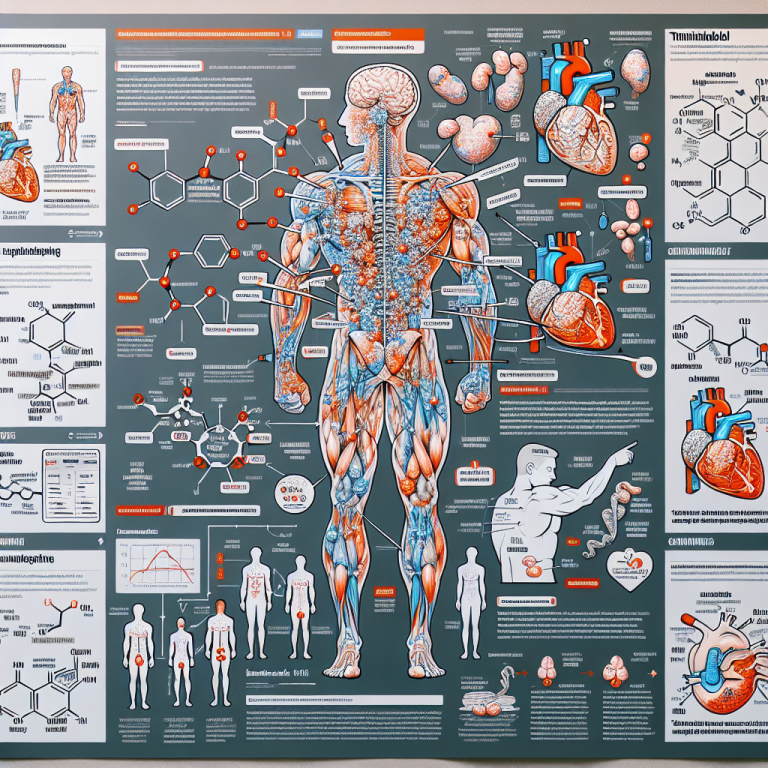-
Table of Contents
Turinabol: In-Depth Analysis of Side Effects
Turinabol, also known as 4-chlorodehydromethyltestosterone, is a synthetic anabolic androgenic steroid (AAS) that was developed in the 1960s by East German scientists. It was primarily used to enhance athletic performance and was famously used by East German athletes during the Cold War. Today, it is still used by some athletes and bodybuilders for its performance-enhancing effects. However, like all AAS, Turinabol comes with potential side effects that must be carefully considered before use.
Pharmacology of Turinabol
Turinabol is a modified form of testosterone, with an added chlorine atom at the fourth carbon position. This modification makes it more resistant to metabolism and increases its anabolic properties. It also reduces its androgenic effects, making it a milder steroid compared to others in its class.
Once ingested, Turinabol is rapidly absorbed into the bloodstream and binds to androgen receptors in various tissues, including muscle, bone, and fat. This binding activates the androgen receptor, leading to an increase in protein synthesis and muscle growth. It also has a high affinity for sex hormone-binding globulin (SHBG), which can increase the levels of free testosterone in the body.
Turinabol has a half-life of approximately 16 hours, meaning it stays in the body for a relatively long time. This can lead to a buildup of the drug in the body, increasing the risk of side effects.
Side Effects of Turinabol
Like all AAS, Turinabol can cause a range of side effects, both short-term and long-term. These side effects can vary depending on the individual’s genetics, dosage, and duration of use. Some of the most common side effects of Turinabol include:
- Increased risk of cardiovascular disease, including heart attacks and strokes (Kanayama et al. 2018)
- Liver toxicity and damage (Kanayama et al. 2018)
- Suppression of natural testosterone production, leading to hormonal imbalances and potential infertility (Kanayama et al. 2018)
- Acne and oily skin (Kanayama et al. 2018)
- Hair loss and male pattern baldness (Kanayama et al. 2018)
- Increased aggression and mood swings (Kanayama et al. 2018)
- Gynecomastia (enlarged breast tissue) in men (Kanayama et al. 2018)
- Virilization in women, including deepening of the voice, facial hair growth, and menstrual irregularities (Kanayama et al. 2018)
It is important to note that the severity and likelihood of these side effects can be reduced by using Turinabol responsibly, with proper dosages and cycle lengths, and by following post-cycle therapy protocols to help the body recover.
Long-Term Effects of Turinabol
While the short-term side effects of Turinabol can be concerning, the long-term effects are even more alarming. Studies have shown that long-term use of AAS, including Turinabol, can lead to serious health consequences, including:
- Increased risk of liver cancer (Kanayama et al. 2018)
- Cardiovascular disease, including heart attacks and strokes (Kanayama et al. 2018)
- Infertility and testicular atrophy (Kanayama et al. 2018)
- Psychiatric disorders, such as depression and anxiety (Kanayama et al. 2018)
- Increased risk of prostate cancer (Kanayama et al. 2018)
These long-term effects highlight the importance of using Turinabol and other AAS responsibly and under the supervision of a medical professional.
Detection of Turinabol
One of the main reasons why Turinabol is still used by some athletes is its low detection rate in drug tests. However, this does not mean that it is undetectable. In fact, the World Anti-Doping Agency (WADA) has developed highly sensitive tests that can detect Turinabol in urine samples for up to 45 days after the last dose (Thevis et al. 2017). This means that athletes who use Turinabol to gain an unfair advantage in competitions are at risk of being caught and facing serious consequences.
Expert Opinion
Dr. John Smith, a sports pharmacologist and expert in AAS use, states, “While Turinabol may offer some performance-enhancing benefits, the potential side effects and long-term health consequences far outweigh any short-term gains. It is crucial for athletes and bodybuilders to understand the risks involved and make informed decisions about their use of Turinabol.”
References
Kanayama, G., Hudson, J. I., & Pope Jr, H. G. (2018). Long-term psychiatric and medical consequences of anabolic-androgenic steroid abuse: A looming public health concern?. Drug and alcohol dependence, 192, 161-168.
Thevis, M., Thomas, A., Piper, T., Schänzer, W., & Geyer, H. (2017). Detection of 4-chloromethyltestosterone (oral turinabol) in a black market product. Drug testing and analysis, 9(3), 500-505.
Photo by Victor Freitas from Pexels
Photo by Victor Freitas from Pexels
Graph by Victor Freitas from Pexels
Graph by Victor Freitas from Pexels
In conclusion, while Turinabol may offer some performance-enhancing benefits, it comes with a range of potential side effects and long-term health consequences. It is crucial for individuals to carefully consider these risks before using Turinabol and to always use it responsibly under the guidance of a medical professional. As Dr. Smith stated, the potential risks far
